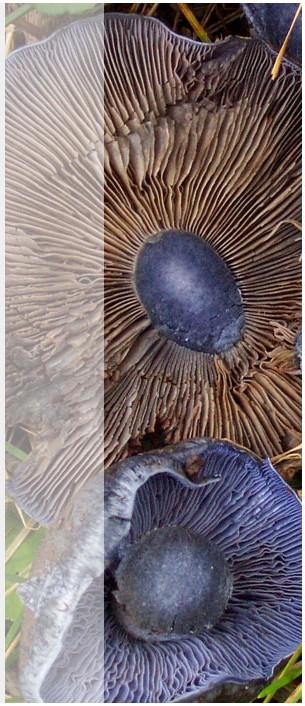Have No Fear! Identifying
Avoid the Perils
Learn to identify the deadly poisonous mushrooms as well as the choice edibles.
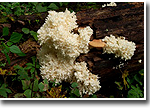 While perusing your guidebook, study the deadly poisonous mushrooms so when you are in the field, their traits will arouse suspicion and signal you to be more cautious or to avoid them entirely. Become familiar with the Gallerina, Amanitas, Inocybes, and Cortinarius. Although these are not the only deadly mushrooms, these are a few of the groups you are likely to encounter. It should become automatic that when you see a tall. beautiful, white-gilled mushroom with a white skirt around the stem and a swollen base, a red flag goes up urging caution. These are the traits of the family of Amanitas which contains some fine edibles and an important entheogen as well as some of the most deadly. Likewise, if you see a cottony veil (cortina) it may be a Cortinarius which contains some of the most insidiously deadly members in that symptoms of poisoning do not appear until some weeks after they have been eaten making the identification of the offender that much more difficult.
While perusing your guidebook, study the deadly poisonous mushrooms so when you are in the field, their traits will arouse suspicion and signal you to be more cautious or to avoid them entirely. Become familiar with the Gallerina, Amanitas, Inocybes, and Cortinarius. Although these are not the only deadly mushrooms, these are a few of the groups you are likely to encounter. It should become automatic that when you see a tall. beautiful, white-gilled mushroom with a white skirt around the stem and a swollen base, a red flag goes up urging caution. These are the traits of the family of Amanitas which contains some fine edibles and an important entheogen as well as some of the most deadly. Likewise, if you see a cottony veil (cortina) it may be a Cortinarius which contains some of the most insidiously deadly members in that symptoms of poisoning do not appear until some weeks after they have been eaten making the identification of the offender that much more difficult.
Make Sporeprints Part of Your Mushroom Hunting Routine
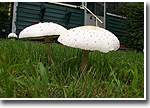 Sporeprints are an important tool in mushroom identification. I doubt that any mushroom poisonings have occurred with mushrooms that were identified with the aide of their sporeprint. Most mushrooms within the same family have the same color spores. All Amanitas have light spores and all Cortinarius have rust colored spores. Many poisonings are caused by the green spored lepioa. Shown to the left, it has green spores. It looks similar to some edible mushrooms, but can be differentiated by the green spores.
Sporeprints are an important tool in mushroom identification. I doubt that any mushroom poisonings have occurred with mushrooms that were identified with the aide of their sporeprint. Most mushrooms within the same family have the same color spores. All Amanitas have light spores and all Cortinarius have rust colored spores. Many poisonings are caused by the green spored lepioa. Shown to the left, it has green spores. It looks similar to some edible mushrooms, but can be differentiated by the green spores.
There Are No Deadly Poisonous Boletes
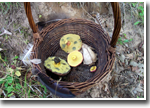 All the deadly poisonous mushrooms have gills. There are many choice edibles that do not have gills. Some Boletes are suspected of causing ill effects in some individuals but these have either a red pore surface or stain blue. The “Peppery Bolete” (B.pipertus) is listed as poisonous in many guidebooks on mushrooms of N.America, so when I eat them, I imagine I am at a fabulous European estate as the same mushroom is listed as “peppery” across the pond. The “Bitter Bolete” is not poisonous but is so bitter that consuming it would probably be quite unpleasant. Taste a small bit of the cap and spit it out. If you get a bitter sensation, pass it by.
All the deadly poisonous mushrooms have gills. There are many choice edibles that do not have gills. Some Boletes are suspected of causing ill effects in some individuals but these have either a red pore surface or stain blue. The “Peppery Bolete” (B.pipertus) is listed as poisonous in many guidebooks on mushrooms of N.America, so when I eat them, I imagine I am at a fabulous European estate as the same mushroom is listed as “peppery” across the pond. The “Bitter Bolete” is not poisonous but is so bitter that consuming it would probably be quite unpleasant. Taste a small bit of the cap and spit it out. If you get a bitter sensation, pass it by.
There Are No Deadly Poisonous Chanterelles
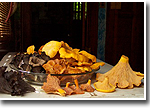 Chanterelles can be identified by their ridges instead of gills. They come in a variety of colors and have light spore prints. None are known to be deadly although the “Scaly vase Chanterelle” is reported in guidebooks to cause stomach upset. There is a “False Chanterelle” which is listed among the poisonous by some though it is not. I have eaten it without incident.
Chanterelles can be identified by their ridges instead of gills. They come in a variety of colors and have light spore prints. None are known to be deadly although the “Scaly vase Chanterelle” is reported in guidebooks to cause stomach upset. There is a “False Chanterelle” which is listed among the poisonous by some though it is not. I have eaten it without incident.
Read the Text in the Guidebooks
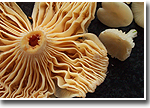 Many mushrooms listed as “poisonous” are not deadly. Some listed as poisonous are suspected of causing stomach upset in some individuals. Some are entheogens so may cause people to “see” things they may not be open to or prepared for. I have eaten blue-staining Boletes, peppery Boletes, A.muscaria and false Chanterelles. One of my favorite mushrooms is a Pholiota which is thought by many to be poisonous. There is even a song that warns of it. It has the smell of garlic and I have been told on more than one occasion that it is poisonous and do not eat it. Never experiment with mushrooms listed as deadly.
Many mushrooms listed as “poisonous” are not deadly. Some listed as poisonous are suspected of causing stomach upset in some individuals. Some are entheogens so may cause people to “see” things they may not be open to or prepared for. I have eaten blue-staining Boletes, peppery Boletes, A.muscaria and false Chanterelles. One of my favorite mushrooms is a Pholiota which is thought by many to be poisonous. There is even a song that warns of it. It has the smell of garlic and I have been told on more than one occasion that it is poisonous and do not eat it. Never experiment with mushrooms listed as deadly.
Avoid Gluttony and Sloth
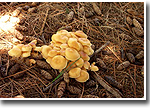 I suspect that some of the individuals that came up with “the 7 Deadly Sins” were mycophagists as gluttony and sloth are two of a mushroom hunters enemies. I know of individuals becoming ill after eating too much Hericium, too many Blewitts, and even too many Morels. Fungi is notoriously hard to digest being composed of , among other things, a material called chitin which is the same thing that makes up lobster shells and black coral and is similar to that which makes up hair and nails. The implications of consuming a large quantity of any of these things would have consequences so be aware. Many people would benefit from occasional purging but I would rather it be by choice than by accident. Process your harvest within a reasonable amount of time (hours not days) as some mushrooms develop characters that are unappealing if processing is delayed. Mushrooms will continue to deteriorate in the refrigerator so trying to extend the “fresh mushroom experience” may have negative implications. I have eaten close to 100 different types of fungi and only suffered ill-effects from over consuming or delay. I rapidly recovered from both incidents though the lesson was duly noted.
I suspect that some of the individuals that came up with “the 7 Deadly Sins” were mycophagists as gluttony and sloth are two of a mushroom hunters enemies. I know of individuals becoming ill after eating too much Hericium, too many Blewitts, and even too many Morels. Fungi is notoriously hard to digest being composed of , among other things, a material called chitin which is the same thing that makes up lobster shells and black coral and is similar to that which makes up hair and nails. The implications of consuming a large quantity of any of these things would have consequences so be aware. Many people would benefit from occasional purging but I would rather it be by choice than by accident. Process your harvest within a reasonable amount of time (hours not days) as some mushrooms develop characters that are unappealing if processing is delayed. Mushrooms will continue to deteriorate in the refrigerator so trying to extend the “fresh mushroom experience” may have negative implications. I have eaten close to 100 different types of fungi and only suffered ill-effects from over consuming or delay. I rapidly recovered from both incidents though the lesson was duly noted.
Be Selective in Your Harvest
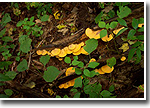 Avoid fungi that are old, infested or in an obvious state of decay. (duh) That huge Bolete or Horse mushroom may be occupied. Humans are not the only beings to enjoy dining on wild mushrooms. Centipedes, fungus gnat larvae and miscellaneous beetles have a fine time eating and dwelling in mushrooms. Do not be alarmed if you encounter them, simply set the mushroom down and move on. Before you harvest, inspect for holes. Gently pinch the sides of the mushroom. It should be firm, not squishy. Cut the mushroom below the cap and check for the tiny tunnels at the stem. A few tunnels are of no concern. I am certain I have unwittingly consumed the larvae of the fungus gnat….it is extra protein and in fact, insects are predicted to be a more accepted food source in the future. If you see them, they can be removed with the tip of a knife. Large mature fungus specimens are more likely to be infested so concentrate you harvest on mushrooms who have opened enough to release some spores but are not fully expanded.
Avoid fungi that are old, infested or in an obvious state of decay. (duh) That huge Bolete or Horse mushroom may be occupied. Humans are not the only beings to enjoy dining on wild mushrooms. Centipedes, fungus gnat larvae and miscellaneous beetles have a fine time eating and dwelling in mushrooms. Do not be alarmed if you encounter them, simply set the mushroom down and move on. Before you harvest, inspect for holes. Gently pinch the sides of the mushroom. It should be firm, not squishy. Cut the mushroom below the cap and check for the tiny tunnels at the stem. A few tunnels are of no concern. I am certain I have unwittingly consumed the larvae of the fungus gnat….it is extra protein and in fact, insects are predicted to be a more accepted food source in the future. If you see them, they can be removed with the tip of a knife. Large mature fungus specimens are more likely to be infested so concentrate you harvest on mushrooms who have opened enough to release some spores but are not fully expanded.
Exercise Caution When Harvesting Small Puffballs
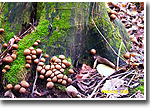 The button stage of deadly Amanitas may resemble a small puffball. Take care to cut the mushroom in half. If it is a puffball, it will be a solid white whereas the young Amanita will have the appearance of a “fetal” mushroom with an infant stem and cap. If you are not able to distinguish whether the interior is solid, set it down and move on.
The button stage of deadly Amanitas may resemble a small puffball. Take care to cut the mushroom in half. If it is a puffball, it will be a solid white whereas the young Amanita will have the appearance of a “fetal” mushroom with an infant stem and cap. If you are not able to distinguish whether the interior is solid, set it down and move on.
Different People Have Different Sensitivities
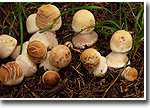 Poisonous mushrooms are not the only cause of misfortune among those who hunt wild mushrooms. When you journey into the Kingdom Fungi you face many perils. People may lose their wayor even fall to their deaths on their quest for the perfect Cep (see article in Guardian). Pay attention to the posted signs. Respect private land owners. It is a good idea to let others know especially if you are going to a new spot in case you lose your way. It is easy to lose your bearings when in unfamiliar surroundings.
Poisonous mushrooms are not the only cause of misfortune among those who hunt wild mushrooms. When you journey into the Kingdom Fungi you face many perils. People may lose their wayor even fall to their deaths on their quest for the perfect Cep (see article in Guardian). Pay attention to the posted signs. Respect private land owners. It is a good idea to let others know especially if you are going to a new spot in case you lose your way. It is easy to lose your bearings when in unfamiliar surroundings.
NEVER EAT MUSHROOMS LISTED AS DEADLY POISONOUS = THEY ARE DEADLY TO ALL
…And Always Beware … MATANGO!
(material referenced after the trailer completes is not endorsed by Mycogoddess.com)
